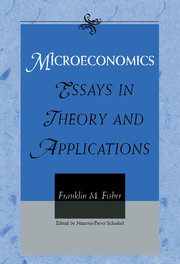Book contents
- Frontmatter
- Contents
- Introduction
- Part I Disequilibrium and Stability
- Part II Welfare Economics and Consumer Theory
- Part III Applications of Microeconomic Theory
- Part IV Industrial Organization, Economics, and the Law
- 24 Organizing Industrial Organization: Reflections on the Handbook of Industrial Organization (1991)
- 25 Reflections on Competition Policy (1993)
- 26 The Social Costs of Monopoly and Regulation: Posner Reconsidered (1985)
- 27 Due Diligence and the Demand for Electricity: A Cautionary Tale (1992)
- 28 Estimating the Effects of Display Bias in Computer Reservation Systems (1990)
- Part V Public Policy Applications
- Epilogue
- Indexes
27 - Due Diligence and the Demand for Electricity: A Cautionary Tale (1992)
Published online by Cambridge University Press: 20 March 2010
- Frontmatter
- Contents
- Introduction
- Part I Disequilibrium and Stability
- Part II Welfare Economics and Consumer Theory
- Part III Applications of Microeconomic Theory
- Part IV Industrial Organization, Economics, and the Law
- 24 Organizing Industrial Organization: Reflections on the Handbook of Industrial Organization (1991)
- 25 Reflections on Competition Policy (1993)
- 26 The Social Costs of Monopoly and Regulation: Posner Reconsidered (1985)
- 27 Due Diligence and the Demand for Electricity: A Cautionary Tale (1992)
- 28 Estimating the Effects of Display Bias in Computer Reservation Systems (1990)
- Part V Public Policy Applications
- Epilogue
- Indexes
Summary
Introduction
Econometrics has proven useful in demand forecasting largely because of its ability to separate the many factors that influence sales. Econometric techniques greatly improve the ability of businesses to understand and respond to market changes. Econometrics can also improve the ability to cope with uncertainty.
It is a commonplace of elementary economics that the quantity demanded depends on price. Yet, in forecasting demand, business people and policy makers often overlook that principle with results that can be very costly indeed. While the immediate subject of this paper is the price elasticity of demand for electricity, the lessons are of wider application.
Carl Kaysen was among the first to recognize the potential of econometrics in analyzing and forecasting demand (and it goes without saying that he did not overlook the importance of price). Nearly 30 years ago, Kaysen suggested to the Research Laboratory of the General Electric Corporation that it sponsor a study
designed to show what modern econometric methods could contribute to the understanding of the forces shaping the demand for electricity. The Corporation had, of course, regularly made forecasts of the growth in demand, in connection with its analyses of markets. However, these forecasts were generally based on correlations of total electricity output with such aggregates as gross national product or industrial production…. The Research Laboratory, to which [Kaysen] was a consultant, expressed an interest in the possibility that a more elaborate analytical technique might yield deeper insights into the probable future course of demand.
- Type
- Chapter
- Information
- MicroeconomicsEssays in Theory and Applications, pp. 411 - 449Publisher: Cambridge University PressPrint publication year: 1999



